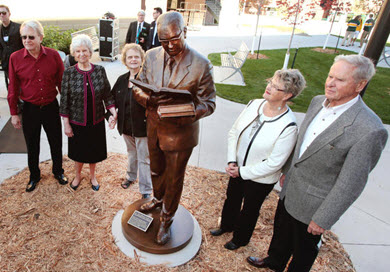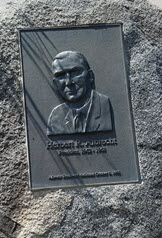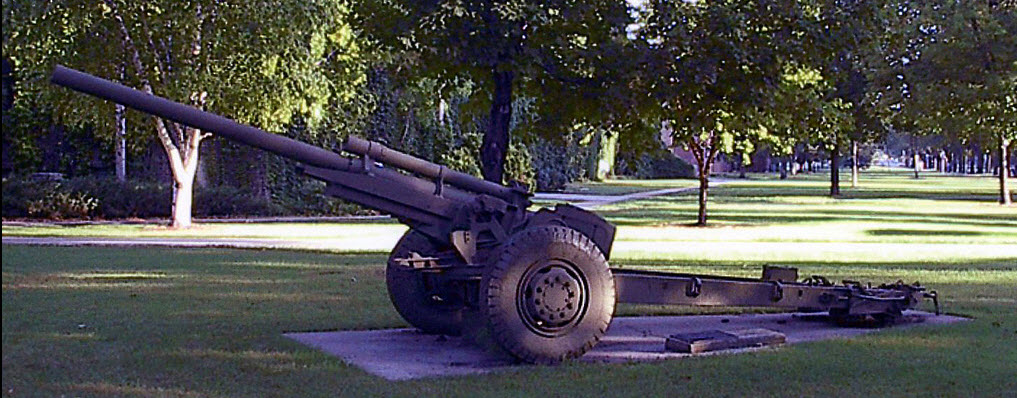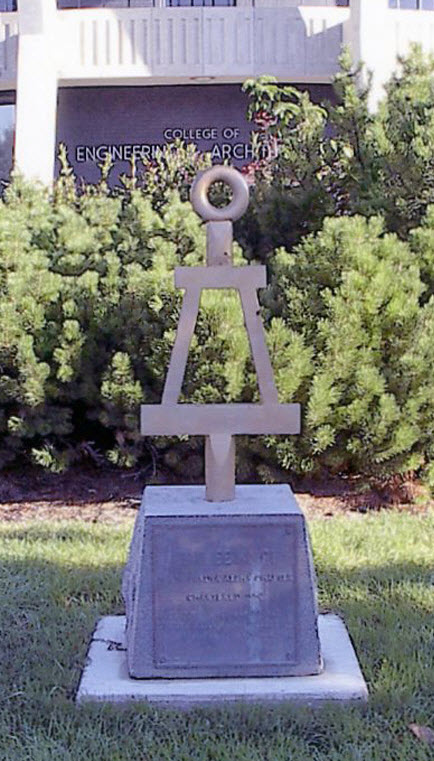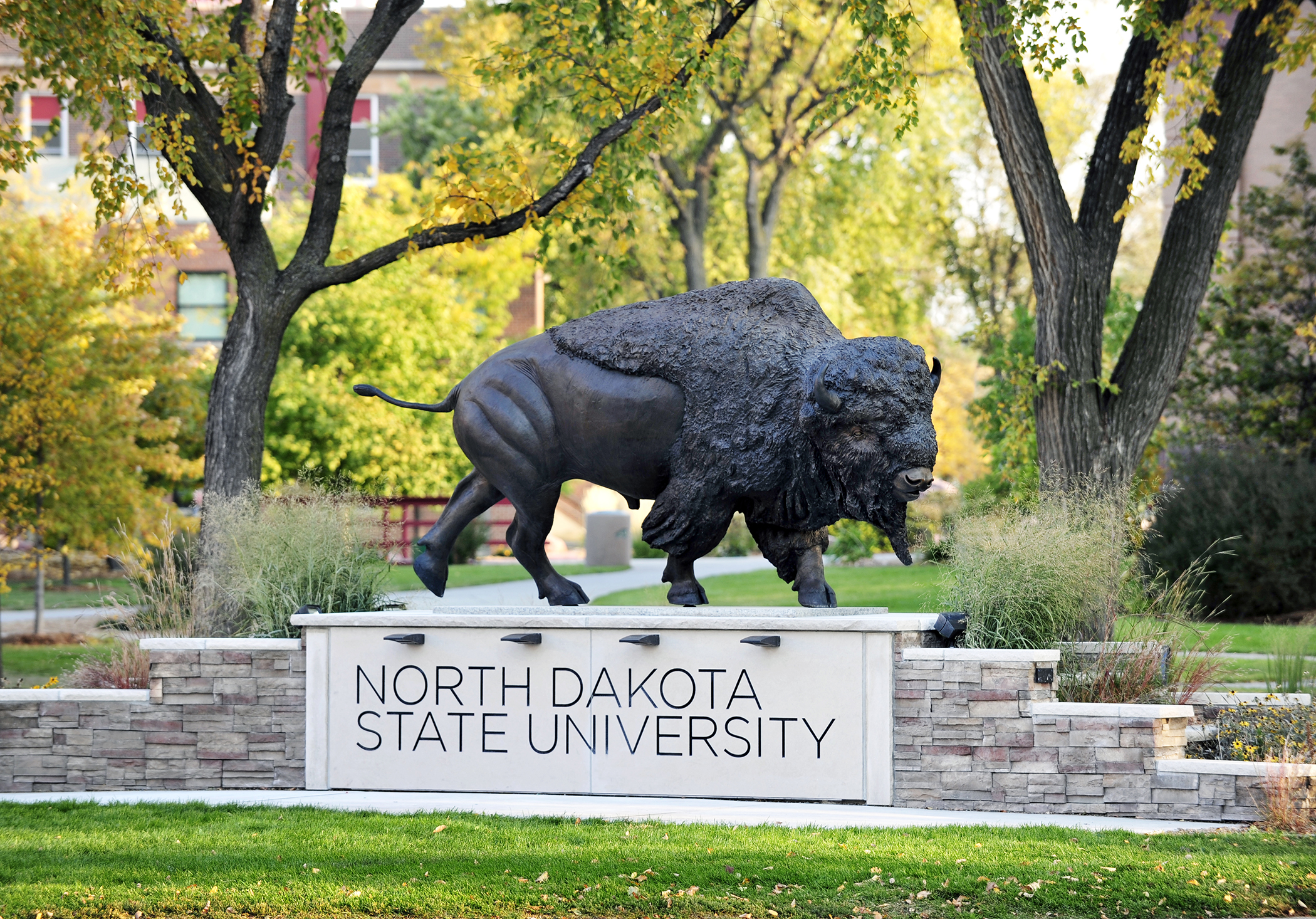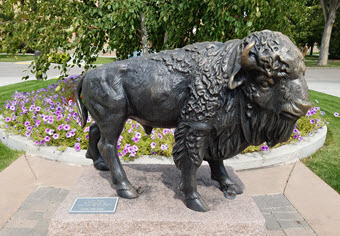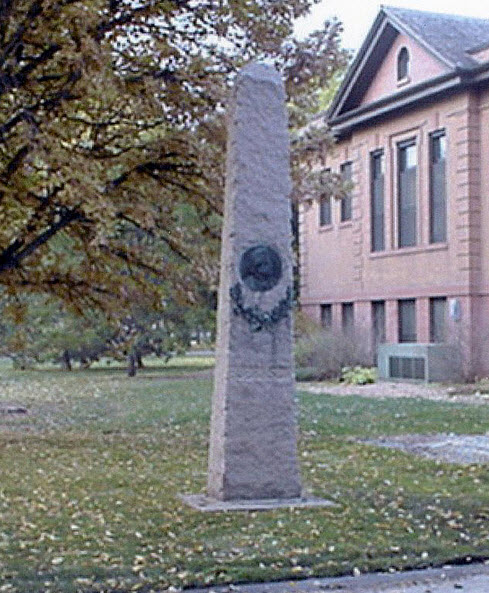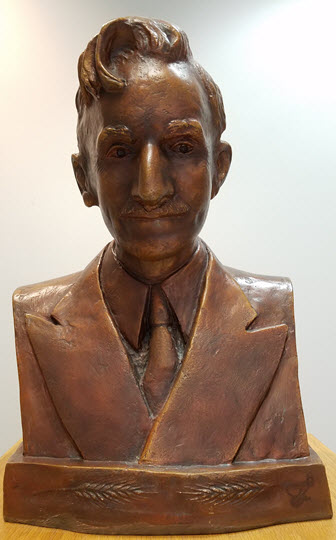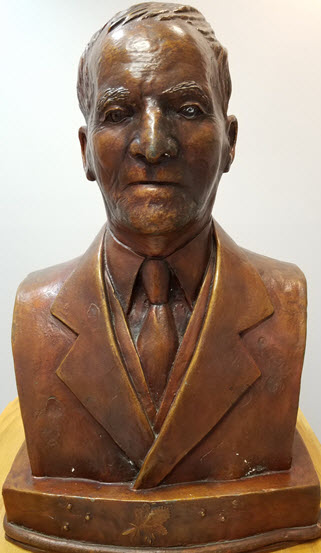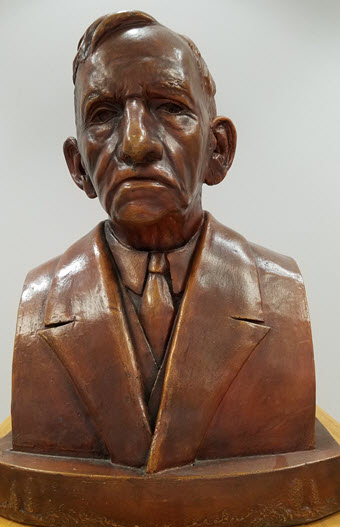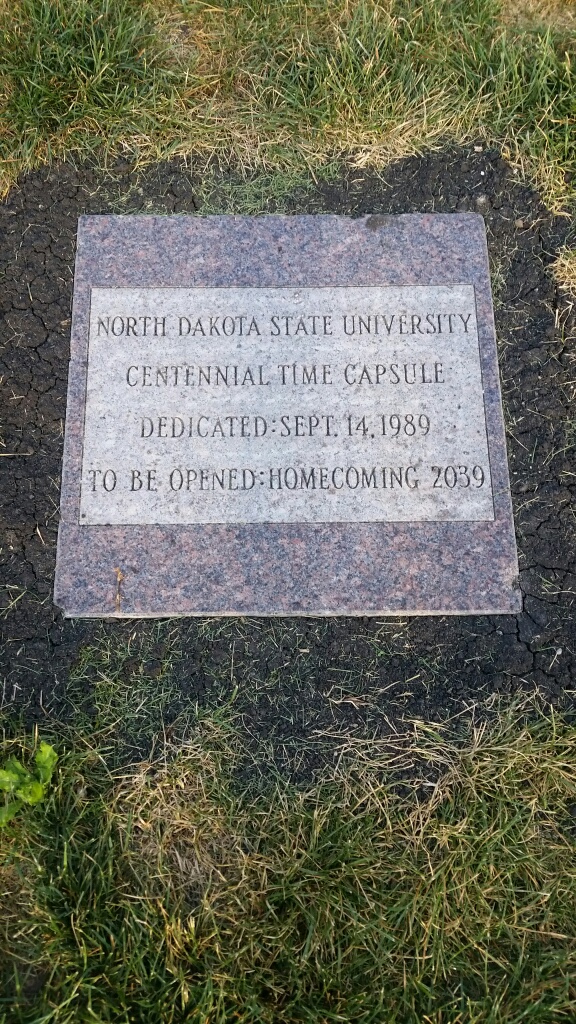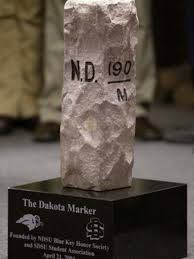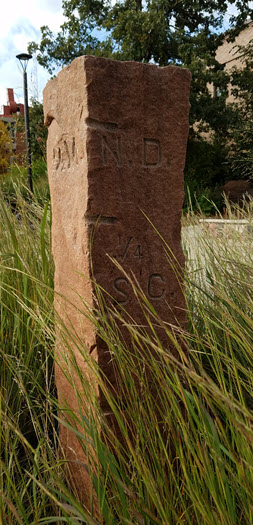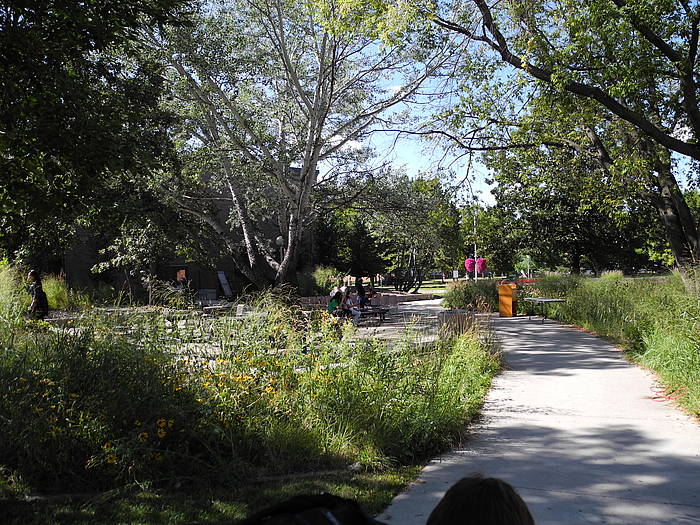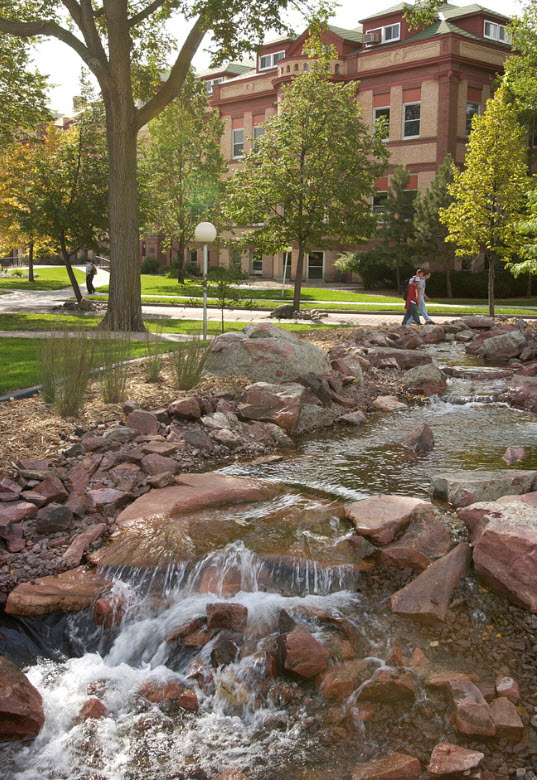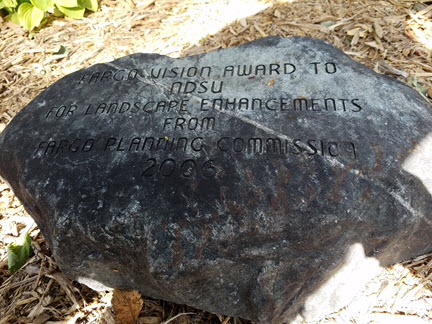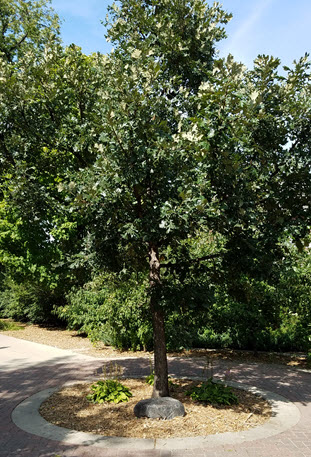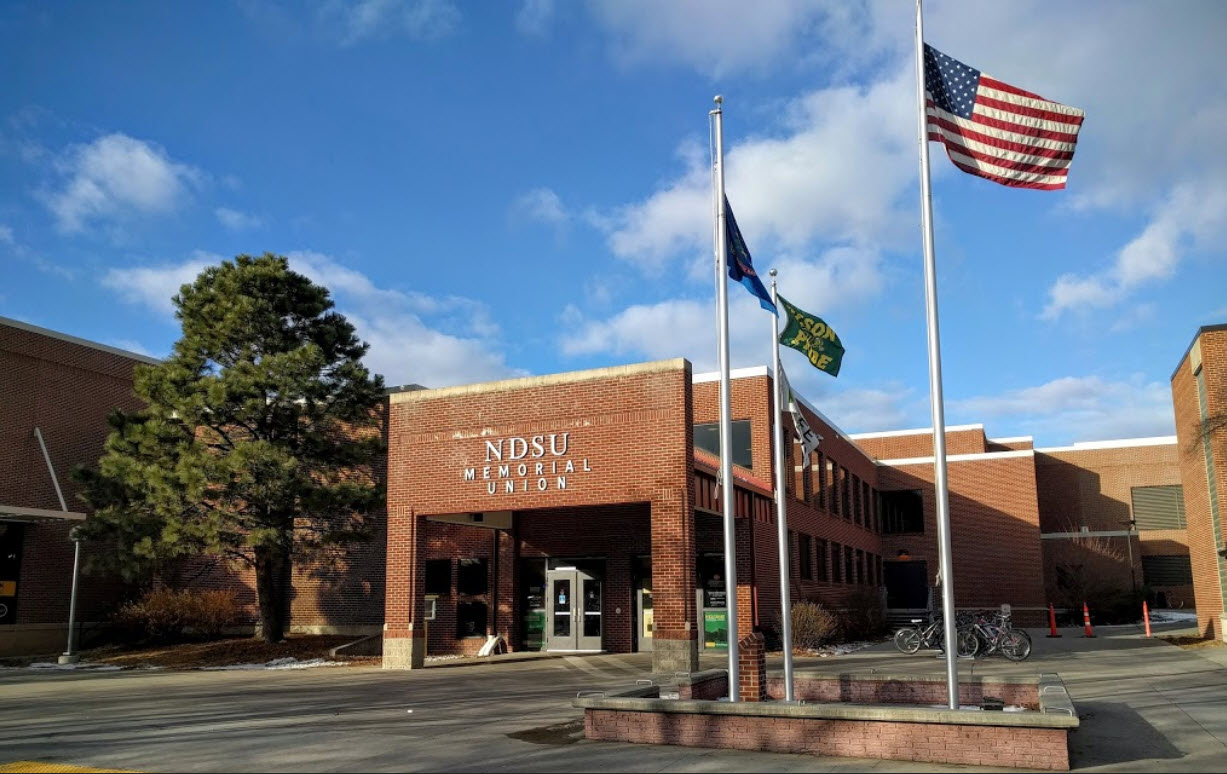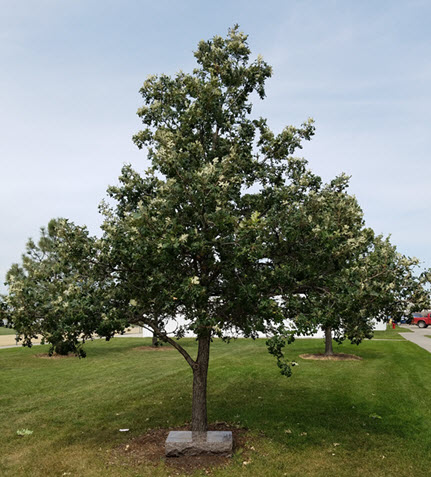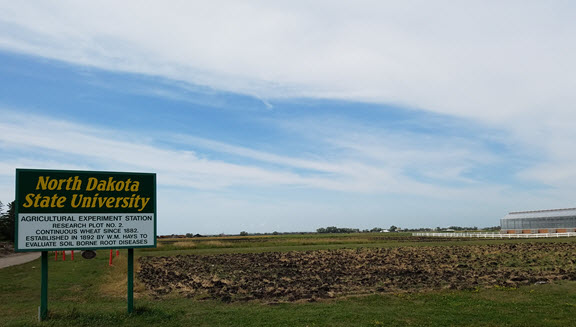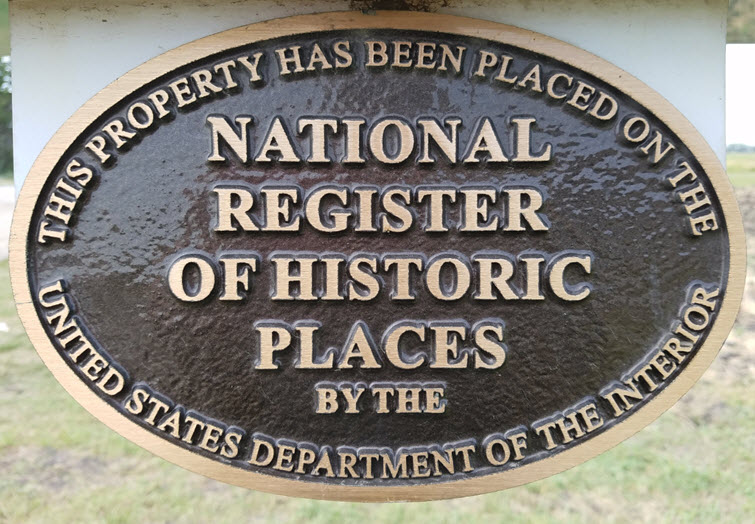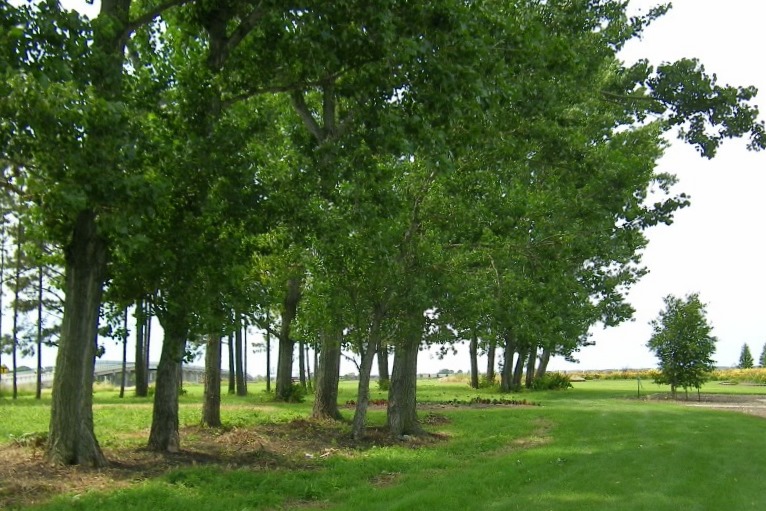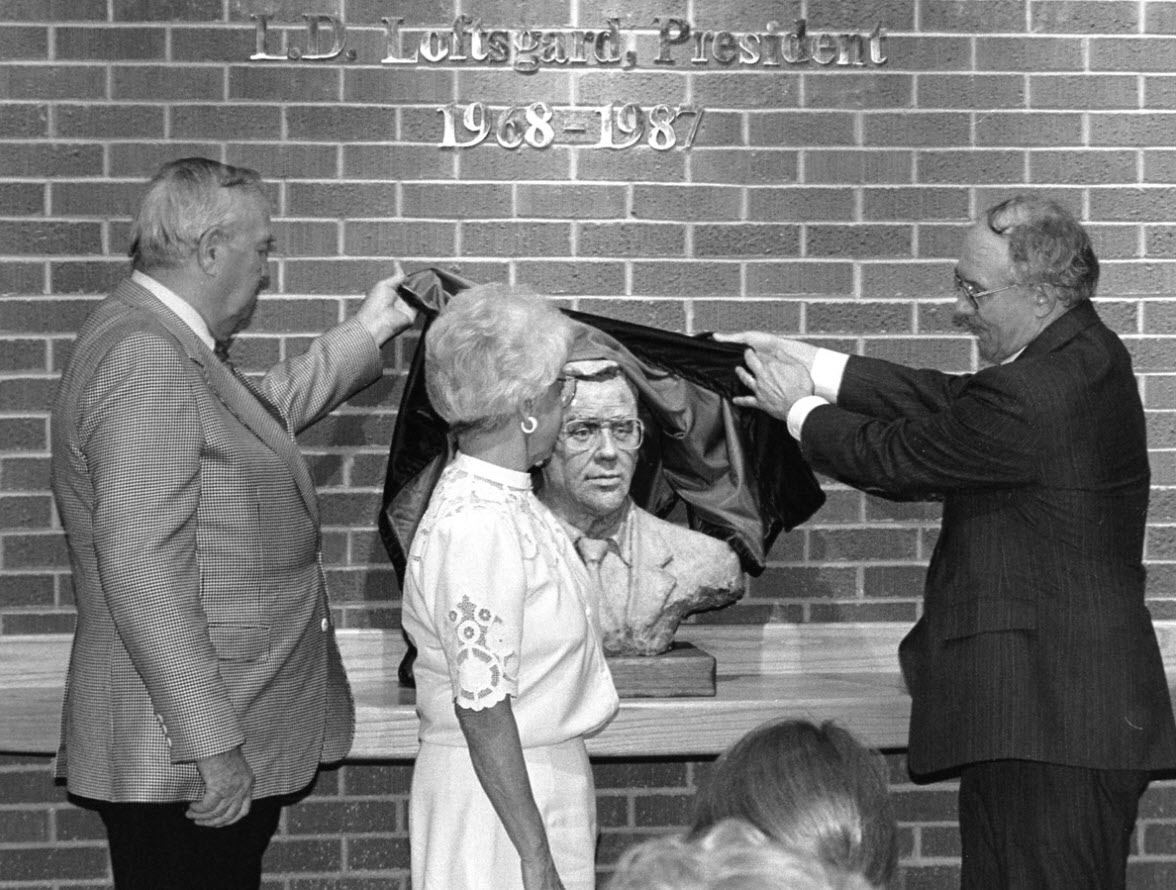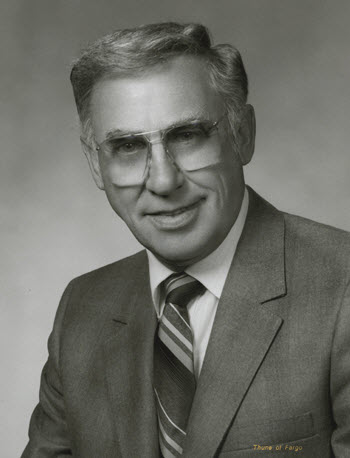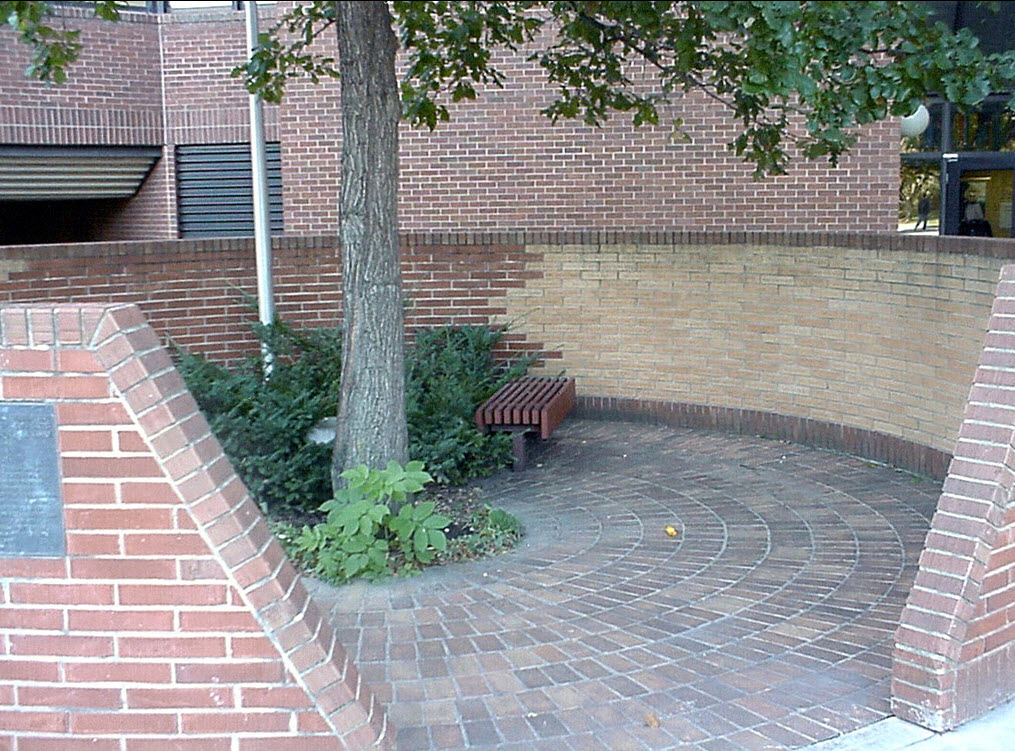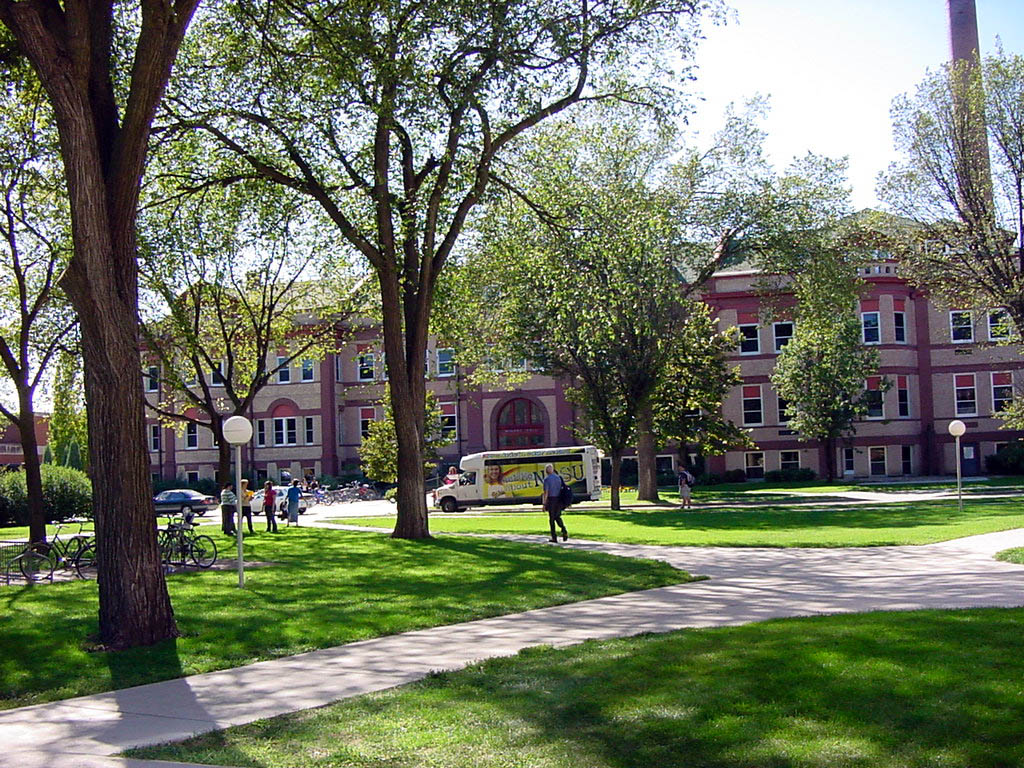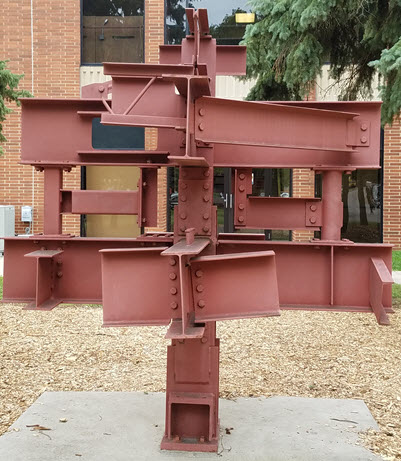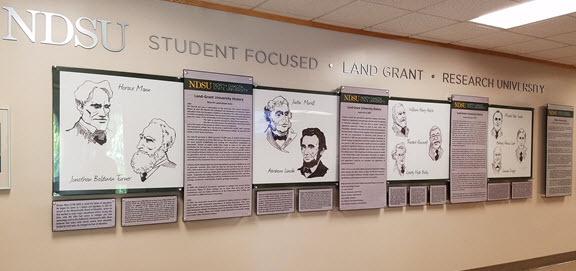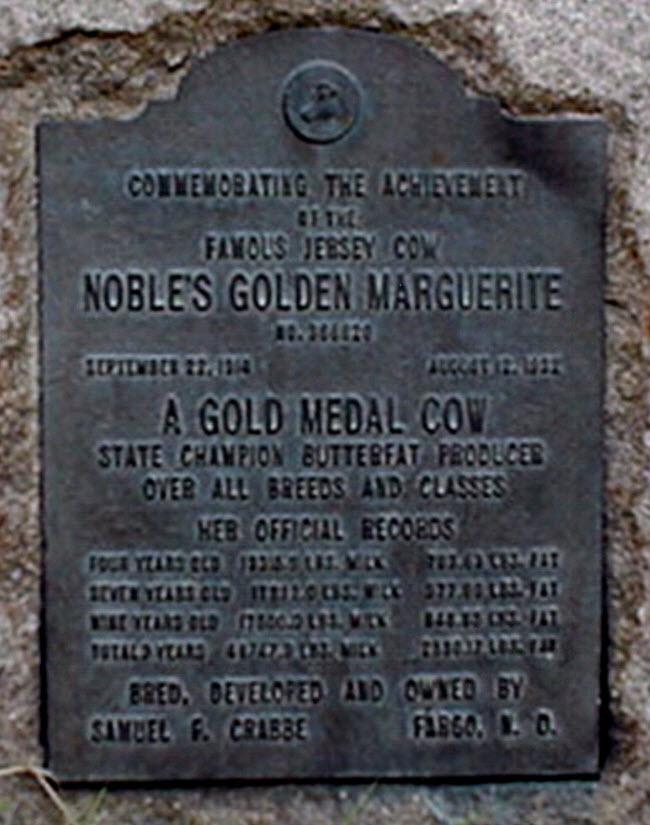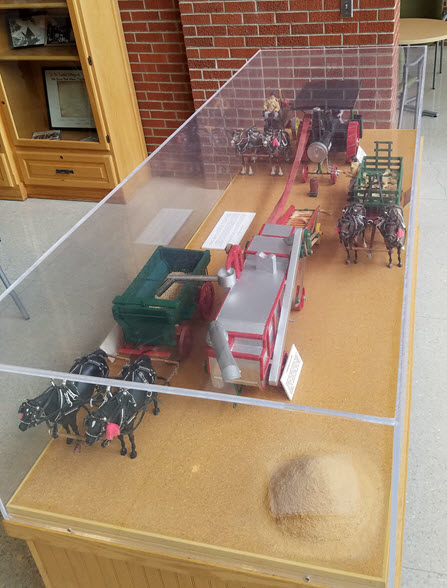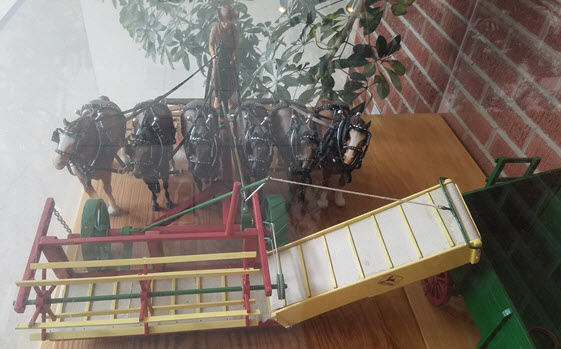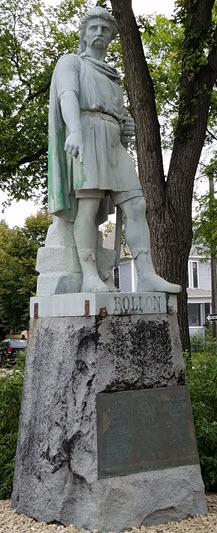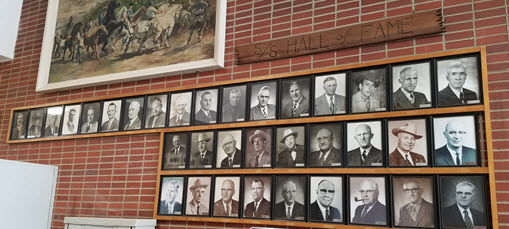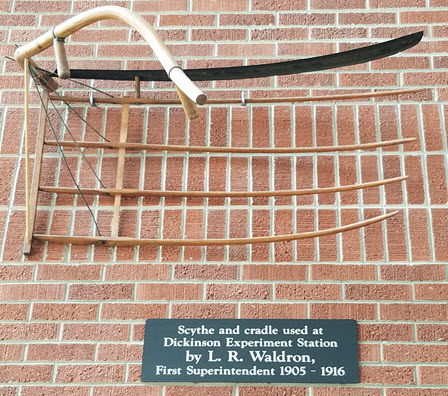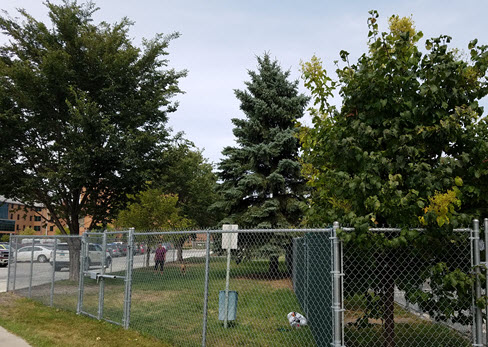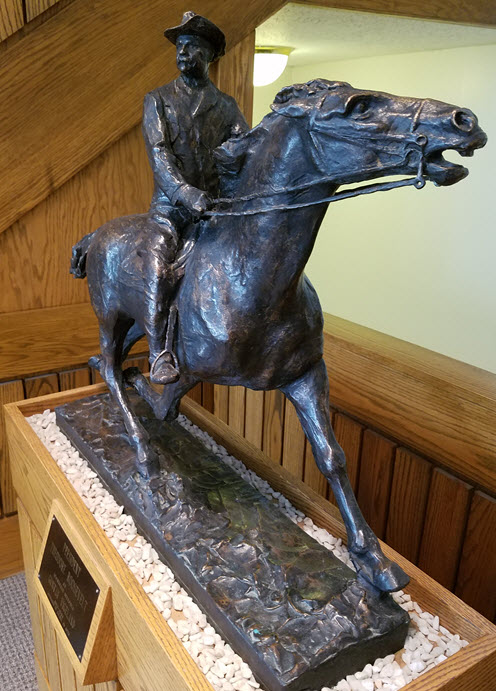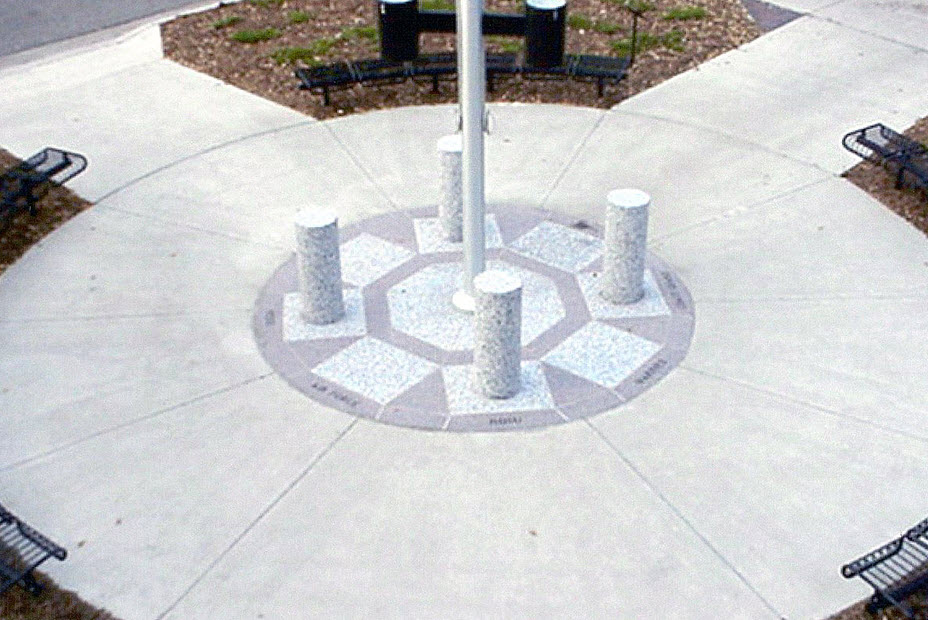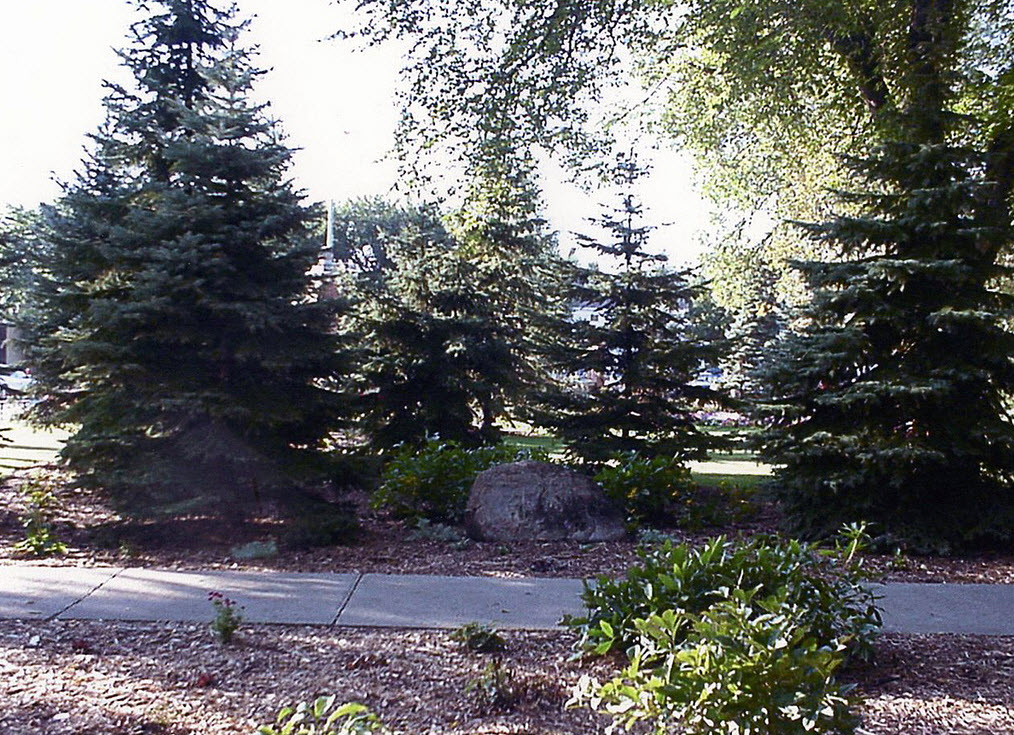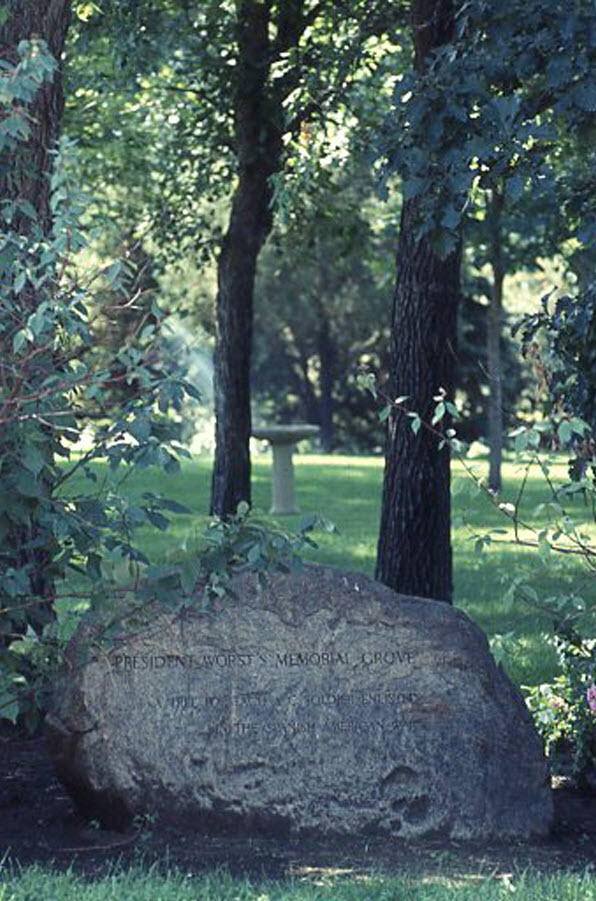A. Glenn Hill Statue
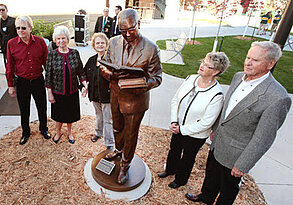
"NDSU’s newest academic building will have a new name after the State Board of Higher Education approved the renaming of the STEM Building to the A. Glenn Hill Center.
The new name honors Professor A. Glenn Hill, a faculty member in the Department of Mathematics from 1927 to 1967 and chair of the department from 1943 to 1967, who had a profound impact on generations of scientists and engineers who graduated from NDSU. The university requested the new name after receiving a substantial gift commitment from a philanthropist who wanted to honor the legendary teacher, author and researcher. The gift will support students studying in fields of mathematics, engineering and science.
The A. Glenn Hill Center opened to classes in January 2016. It is a student-focused environment made up entirely of classrooms, labs and study areas, with an emphasis on science, technology, engineering and mathematics. It is designed for hands-on learning that is a differentiator in the educational environment at NDSU.
Hill was a dedicated teacher and a pioneer in pedagogy and advocacy for mathematics. Under his leadership, the department grew from six full-time members in 1943 to 20 faculty and eight graduate assistants in 1961, while the number of students tripled, and the number of higher-level courses was expanded.
He developed an accelerated program for the department, and was co-author of three books on mathematics, which were widely used at the time. He was the author of a number of publications on mathematics and was instrumental in the adoption of new mathematical concepts and procedures.
During his 39 years at the university, Hill was an active participant in campus events. He was awarded an honorary Doctor of Service Award by Blue Key in 1948, and in 1960 was selected to give the university’s Faculty Lecture, a high honor bestowed by his peers. He led or participated in numerous other campus and community groups.
Hill was born in Erie, North Dakota, to a family dedicated to college education. He was a country school master before entering NDSU and earning his bachelor’s degree in 1927. He took a leave of absence from teaching at NDSU to earn his master of science degree at the University of Wisconsin in 1931.
A 1960 newspaper column described his professionalism, effective but unassuming leadership, and integrity, along with the importance of the department to the institution. “To become an engineer, a chemist and to be adequate in a number of other fields, one most know how to calculate,” the columnist wrote.
The columnist goes on to describe how Hill came to join the faculty: “It was while he was studying calculus that one of the biggest moments of his life occurred. The math department head… summoned him one day and designated him a teaching assistant. This was news to speed to Erie: Glenn was now a ‘college teacher.’ ”
Hill had offers to move on to bright lights in big cities, but always declined. “It’s not that I do not like money or place,” he said. “It is that I like North Dakota, and Fargo, and the college and the young people I work with more.”
Hill died in January 1967, a few months before his scheduled retirement that June. One of the news reports after his death lamented his loss to the university, saying “He had been so much of the school since 1927 that many students can’t remember when he wasn’t a part of it.” The writer also acknowledged his stint as an acting athletic director in 1954 during a period of uncertainty, while maintaining his effectiveness as an instructor. He reportedly had a chance to sign with a major league baseball team when he was 15, but his parents were opposed to Sunday baseball, and so he did not sign. He played college football briefly, until he was injured.
The state of North Dakota provided $29.4 million for the structure, which is located east of the Memorial Union and west of Churchill Field. The 119,505 square-foot facility has 23 labs, nine classrooms and 13 study areas, and the spaces have great flexibility, allowing specific use to change hourly depending on the class schedule. Classroom capacity ranges from 24 to 300 students, and serves up to 5,000 students every day.
NDSU will formally dedicate the new name during Homecoming activities later this fall."
05/24/2016 NDSU News
Albrecht Boulevard
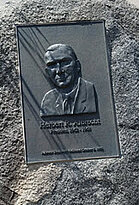
On October 9, 1992, President Albrecht, NDSU President from 1962 - 1968, was celebrated by the dedication of Albrecht Blvd on campus. Two large boulders with plaques have been placed at either end of the road in honor of him and his service to NDSU for that time period.
Anti-Tank Gun
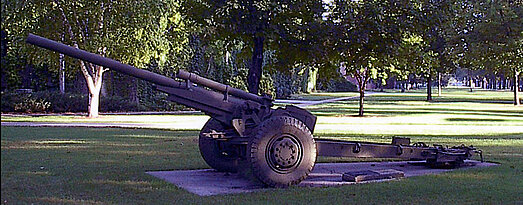
The 10,000-pound, 20+ feet long, World War II anti-tank gun that sits on the lawn southeast of the entrance to Bentson/Bunker Fieldhouse was acquired through the joint efforts of the North Dakota Agricultural College Veterans Club and the North Dakota Agricultural College Reserve Officers Training Corps (ROTC) department.The gun was obtained from the federal arsenal at Rock Island, Ill. The cost of transportation and installing was about $670, and the Fargo American Legion Post helped with some of the costs. Dedication was held on Veterans Day, Nov. 11, 1958.
The plaque was kept blank, anticipating that in the general election of Nov. 4, 1958, North Dakota Agricultural College would become North Dakota State University. The name change proposal was defeated. The vets decided to go with North Dakota State College (NDSC), the name students had been referring to the college since the 1920s.
The plaque reads: “A memorial to all N.D.S.C. veterans, may their contribution to college, state and nation help bring peace and brotherhood to mankind. N.D.S.C. Vet’s Club, November 11, 1958.”
The "Bent" of Tau Beta Pi
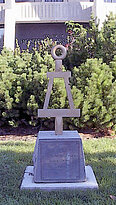
Perhaps you've noticed that metal kind of pyramid thing in concrete slightly to the west of the round administration building of the College of Engineering and Architecture. "Students daily walk past a bent and never even know it. A bent? A bent what? The bent is the national insignia of Tau Beta Pi, SU's chapter of the honorary engineering society. The bent is designed after the supports often used under bridges. The bent outside the engineering buildings was sent to the SU chapter as an unfinished casting. Society member finished the model and mounted it in its present position." (Spectrum, Tuesday, November 7, 1978, p. 9)
The plaque reads: "Tau Beta Pi, North Dakota Alpha Chapter, Chartered 1950, A national engineering honor society recognizing excellence and integrity in Engineering."
Bison Statue #1
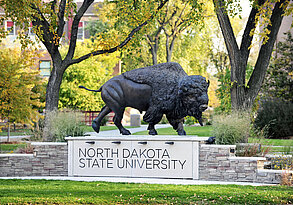
The bison statue sits in front of South Engineering, across from the Library and Minard Hall. It was donated to NDSU by Jim and Sandra Roers, with contributions from Ronald G. and Kaye S. Olson and Student Government. It is dedicated to the memory of Dr. Les Pavek, Vice President of Student Affairs, and Michael William Barner. The statue once stood inside of a bank in Minnesota.
Bison Statue #2
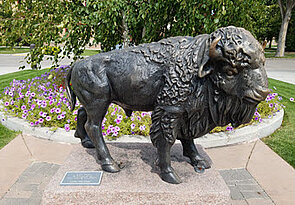
The bison statue that is positioned on the north side of the president's residence in the driveway loop was graciously donated by Ronald G. and Kaye Olson to be displayed at the president's residence.
Bjornson Memorial Obelisk
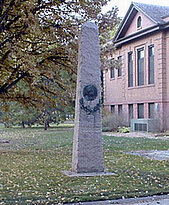
On Tuesday morning, May 17 1904, the Bjornson 'bautasten [obelisk], which had been placed on the North Dakota Agricultural College grounds, near Old Main, was unveiled. This Obelisk is in honor of Bjornstjerne Bjornson (1832-1910), the great Norwegian writer and statesman, who won the Nobel Prize for Literature in 1903. The buildings of NDAC were all decorated with bunting and the flags of Norway and the United States. A large crowd, estimated from three to five thousand, was on the grounds. The granite sculpture is 13 feet tall and weighs 4 tons.
The stone was carved from material brought from a quarry on Bjornstjerne Bjornson’s estate in Norway. After the stone was cut and finished at St. Cloud, Minnesota, the Sons of Norway of Abercrombie, North Dakota, presented it to NDAC. On one side of the Obelisk is a seal with Bjornstjerne Bjornson’s likeness. On the reverse side is the last verse of the Norwegian Nation Anthem, written by Bjornson. Roughly translated into English, it reads: “Yes we love this land of ours as it rises forth furrowed weather-beaten o’er the waters with its thousand homes. As our sires struggles raised it from need to victory, also we, when it’s demanded for its Peace pitch camp.”
The Obelisk still stands south of Old Main, between Putnam Hall and Burgum Hall.
Busts of C.B Waldron, H.L. Bolley and L.R. Waldron
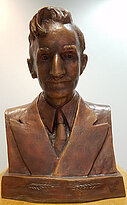
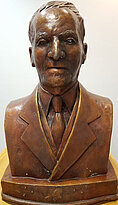
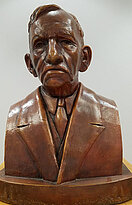
A.M. Christianson, a student of L.R. Waldron and H.L. Bolley, commissioned Ida Bisek Prokop Lee to sculpt their bronze busts, which were presented tot he college at the Golden Anniversary graduation ceremonies May 22, 1944.
Lee, who used North Dakota clay, "worked on those things right up until the ceremony started," and donned a cap and gown to address the graduating class, saying "fields really are greener here in North Dakota...because of the work of the Waldrons and Bolley..."
The North Dakota Horticulture Society presented the C.B. Waldron bust to the college at graduation ceremonies June 11, 1945.
Centennial Time Capsule
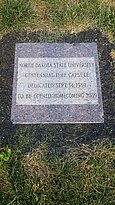
This time capsule was donated and buried in 1989 and is dedicated to 75 years of the FFA meeting at NDSU campus. This time capsule will be opened at Homecoming in 2039.
Dakota Marker
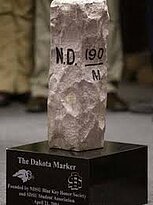

The trophy is a model replica of the quartzite monuments that marked the border between North and South Dakota when Dakota Territory was split into 2 states along the Seventh Standard Parallel (45°56'07" N). The monuments were seven feet tall and ten inches square at the top, and were mined and inscribed near Sioux Falls. 720 markers were placed at half-mile intervals along the border by Charles Bates in the summers of 1891 and 1892. The monuments were inscribed with the initials "N.D." on the north side and "S.D." on the south side.
The trophy itself was proposed by Adam Jones, then-President of the NDSU Chapter of Blue Key National Honor Society, and was unveiled to the public on April 21, 2004 at a ceremony just outside Hankinson, North Dakota, a community near the North Dakota/South Dakota border.
The inscriptions include: N.D., S.D., and 190 M (the distance between Fargo, ND and Brookings, SD along Interstate 29). The trophy weighs nearly 75 pounds and is commonly carried around the field immediately after the game's conclusion by the winning team.
Dakota Plaza/Grandmother Earth's Gift of Life Garden
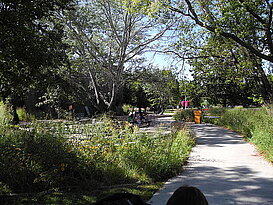
'Grandmother Earth's Gift of Life Garden' to be dedicated at NDSU, 05/22/2009 by Najla Amundson
A new garden honoring American Indians will be dedicated on Monday, June 1, at 1:30 p.m., at the corner of Centennial Boulevard and Administration Ave., on the NDSU campus.
“Grandmother Earth’s Gift of Life Garden” will feature native North Dakota plants. Tribal colleges from around the state will provide soil to add to the garden.
“The earth plays an integral role in Native American culture. There is great importance placed on taking care of the earth. Having NDSU provide a space for this garden shows the university’s respect toward the Native American culture,” said Jacylnn Davis-Wallette, assistant vice president for equity, diversity and global outreach.
The dedication ceremony will include a blessing from a spiritual leader and seeds will be given to those who attend.
NDSU’s Extension service and plant sciences department helped plan the garden. The multicultural student services department sponsors the garden.
Dennis Colliton Memorial
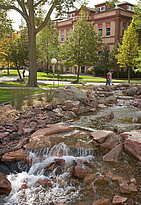
This memorial, located between South Engineering and Agricultural and Biosystems Engineering, debuted in the spring of 2005 as a tribute to Professor Dennis C. Colliton, one of the founders of the landscape architecture program at NDSU, who died suddenly in 2003. The rocks that make up the fountain plaza are called "buffalo-rubbed" rocks which are quartzite. "The polishing seen on some of the rocks is probably associated with glaciation, although some attribute these surfaces to rubbing by bison.”
After the tearing down of the old Mechanical Arts building in 1993, which was adjacent to the northwest of the South Engineering building, a fountain was constructed, but due to leaks and numerous maintenance problems, ideas about replacing it were generated. In 2002, Dennis Colliton spearheaded a landscape architecture competition and the "babbling brook" concept won the competition. Unfortunately, on August 17, 2003, Dennis passed away unexpectedly. Nevertheless, construction on the "babbling brook" began in May of 2004. In the spring of 2005, the "babbling brook," now renamed the Dennis C. Colliton Campus Memorial was dedicated.
Dennis Colliton was born January 24, 1951 in Niagara Falls, New York. The family moved to Minot, North Dakota and Dennis graduated from Minot High in 1969. He received his bachelor‘s in Architecture at North Dakota State University [NDSU] in 1974. He earned a master‘s of landscape architecture from Cornell University in 1976 and his initial professional registration as a landscape architect in 1980.
Colliton joined the faculty of architecture at NDSU in 1976. In 1983, Dennis, with Cecil Elliot, the Chairman of the Architecture Department, founded the landscape architecture program. In 1986 he Dennis became the Program Director of landscape architecture program, and except for 1997-1998 when he served as department chair, he served continuously in the position. He oversaw the initial accreditation process for the program in 1991. In addition to his academic responsibilities, Dennis was also owner of Dennis Colliton Landscape Architects, Fargo
Fallen Bison Memorial

Dedication ceremonies were held Oct. 8 for a campus memorial to honor NDSU alumni, students and staff who have died in service to our country. More than 150 people attended the dedication and first flag raising at the Fallen Bison Memorial, located just south of Bentson-Bunker Fieldhouse.
Retired Gen. Charles Wald, a 1971 NDSU graduate, was the featured speaker. Wald is the former Deputy Commander of the U.S European Command. He also served as Deputy Chief of Staff for Air and Space Operations at the Pentagon.
During his comments, Wald paid tribute to Lt. Robert Schmitt and Capt. Thomas Gramith, whose names are included on the memorial. Schmitt, a 1948 NDSU graduate, was killed in ground combat during the Korean War. Gramith, a 2005 NDSU graduate, died during an Air Force night mission in Afghanistan.
The ceremony featured a color guard of Air Force and Army ROTC Cadets and a three-volley salute by American Legion and Veterans of Foreign Wars members. Air Force ROTC Cadet Patrick A. Bergh played taps.
The 20-feet square memorial is built of brick and granite, with a flagpole in the center dedicated to Schmitt and Gramith.
Donations for the Fallen Bison Memorial can be sent to: NDSU Development Foundation and Alumni Association, PO Box 5144, Fargo, ND 58105-5144.
Fargo Vision Award
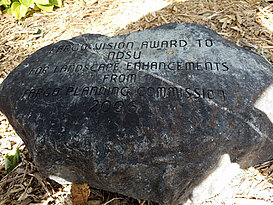
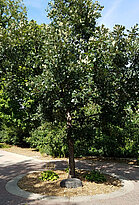
The Fargo City Commission and Fargo Planning Commission presented NDSU with the first annual “Fargo Vision Award” in recognition of the university’s ongoing efforts to beautify the campus. Commissioners presented President Joseph A. Chapman and members of NDSU’s arboretum committee with an engraved landscaping rock during the Sept. 13 planning commission meeting. In addition, a resolution of appreciation was read by planning commission chair John Q. Paulsen.
Chapman thanked the members of the arboretum committee and other members of the university for a number of successful efforts to enhance the appearance of the campus. Recent projects have included renovation of the campus main gate, the horticulture plots at the intersection of 12th Avenue and 18th Street and the hanging flower baskets found across the university.
It's Happening at State - September 20, 2006
Flag Monument of the Memorial Union
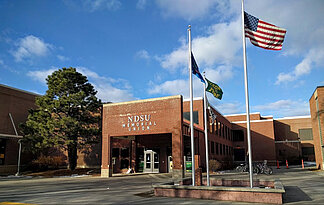
Rededication of the Memorial Union
Frank Bancroft Dedication
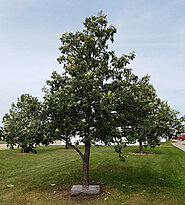
Franklin M. Bancroft served as the director of Auxiliary Dining Services for 32 year. This oak tree is dedicated to him (June 1995) for his progressive, perceptive and sensitive leadership ion serving NDSU and the food industry. Nationwide, offered by his colleagues and friends in appreciation of the fairness, honesty, understanding and dignity with which the treated all of us throughout his long professional career.
Historic Field Plots
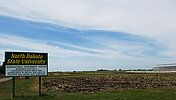
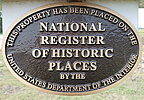
Research plots 2 and 30 were placed on the National Register of Historic Places by the United States Department of the Interior in 1992. The plot's soil has the same general properties of soil in the surrounding Red River Valley. The retreating glacier which created the Valley left in its wake, a large lake known as Lake Agassiz, since reduced to the meandering Red River which flows north to Lake Winnipeg in Canada. As result of this glacial history, the soils for the Valley are rich, finely textured sediments which were deposited as a lake bed.
Because of the desire for controlled and reliable data (as is true of any scientific experiment) there was no introduction of other soils, chemicals or fertilizers into this plot which would have impaired efforts to identify the flax pathogen. Therefore, the plot has remained "pure" as a laboratory which duplicates the regional soil environment in which flax wilt (plot 30) may occur or which wheat (plot 2) is cultivated.
Research plot 30 has been cropped continuously to flax for nearly a century. The field is cultivated each fall and then sown to flax in the spring. Evaluations of the disease of the various flax genotypes are made and recorded during the summer.
Research plot 2 is still being cropped continuously to wheat. The field is cultivated in the fall and then sown to spring and durum wheat early each spring. The plant genotypes are evaluated for root disease resistance each fall and the data recorded.
Kiesling Grove
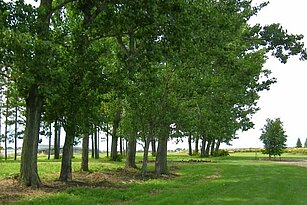
Kiesling Grove (also known as the Shade Garden) in honor of the Plant Pathology Chair who had this area planted, this area is comprised mostly of cottonwood and pine trees. An area for annuals is here as well as ferns and hostas.
Loftsgard Memorial
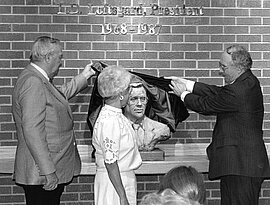

Laurel D. Loftsgard was the first NDSU alumnus to serve as president of NDSU. He was born in Hoople, N.D., in 1926. He served in the armed forces after graduating high school and again during his collegiate career. Loftsgard earned his bachelor's degree in agricultural economics from NDAC in 1954, and master’s and doctoral degrees from Iowa State.
Loftsgard returned to NDAC as an assistant professor of agricultural economics in 1958 and was appointed vice president for academic affairs in 1966. He was appointed acting president in January 1968 and made permanent by the Board of Higher Education six months later. During his presidency, enrollment increased by more than 50 percent and building projects worth more than $30 million were undertaken. Loftsgard spearheaded creation of the NDSU Development Foundation and many other achievements. He received Blue Key's Doctor of Service Award in 1980.
President Loftsgard died of cancer in early October 1987 after serving as NDSU's president for 19 years. The new crop and weed sciences building was dedicated L.D. Loftsgard Hall in 1991.
Main Gates
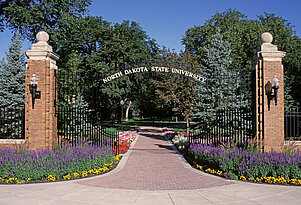
"Large Crowd Witnessed Ceremonies: last Thursday noon there gathered at the gateway, an enthusiastic crowd of faculty and students and at the appointed hour, Pres. Worst picked up a shovel and turned the first sod in preparation of the construction of the new gateway. The President remarked that after twenty-one years of waiting, a permanent gateway was to be erected due to the initiative and efforts of the class of 1912 and Mark Heller in particular.
This gateway is to extend from the hedge on the south boundary of the campus to the north side of the walk making a total of 80 feet. There will be four large pillars on either side of the drive and one on either side of the walk. These four pillars will be connected by a panel work and an ornamental seat, backed by grill work will be placed between the two central pillars. The structure will be set deep into concrete and will be built of brick, sandstone and granite. There will be an ornamental urn at the top of each pillar, about which large electric lights will be placed on the campus and street sides. The iron grill work will be artistic.
The class of 1912 and Mark Heller, its hustling member, are to be congratulated upon this effort to perpetuate their memory on the campus. … Haxby and Gillespie the leading architects of the city have kindly lent their services to the Board by presenting them the plans of this gateway.” (Excepts of the article taken from the September 24, 1912 Spectrum, p.3)
For several decades, visitors passed through the gate on a roadway that ran from the corner to the front steps of Old Main. It served as the main entrance to the campus until 1950, when the road was removed and replaced with a pedestrian path and grassy mall.
The gate was damaged during the 1957 tornado that struck the north side of Fargo. In 1969, the current decorative gate, with its entryway welded shut, was installed. In October 2001, the “Main Campus Gate Re-opened. The NDSU main gate has been re-opened to pedestrian traffic for the first time in more than 30 years. During the ceremonies Oct. 5, President Joseph A. Chapman said, “In terms of both literal and figurative, NDSU is opening up to a great future. Our campus is opening the gates to progress.”
Memorial Plaza
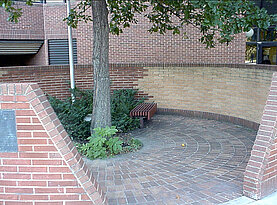
The Memorial Plaza was the brainchild of then Dean of Home Economics, Katherine K. Burgum and Richard Weltzin, Foundation Coordinator, NDSU Alumni Association.
In order to assist with fundraising for the Family Life Center*, the National Women's Committee, headed by Jean Mason Guy (Class of 1944), was organized to help in the campaign. "Some 242 alumnae personally contacted members of their classes to complete the $100,000 goal set by the National Women's Committee. Surpassing their goal, over $150,000 was given to the Family Life Center." (Dedication program, October 1, 1976)
The Plaza contains over 700 bricks, each with the name of the person or group who donated the brick. The brick contributions were $60 or more to the building fund for the Family Life Center. Bricks for the Plaza were donated by Hebron Brick; Twin City Construction Company donated services; the North Dakota Masonry Institute donated the labor to lay the bricks; and Dakota Monument Company did the engraving of the names.
*The Family Life Center was rededicated the Katherine Kilbourne Burgum Family Life Center in September 1998.
Memorial Trees
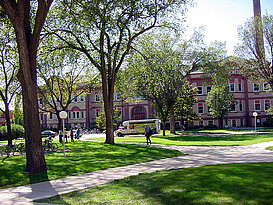
Trees have been planted on the campus of North Dakota State University in remembrance of these students, faculty and staff.
Metal Statue
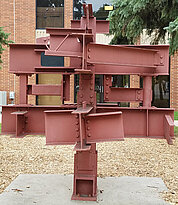
The Metal Statue located near the CIE building was a donation to the campus from Mid-American Steel Company in 2001.
Morrill Artwork
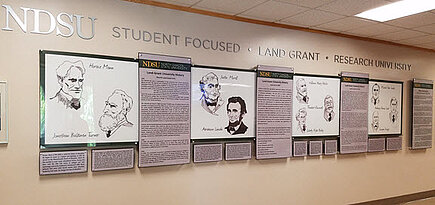
Located in the main entry hallway of Morrill Hall, is a grand display of the history of the Land Grant University, the founders of the Land Grant, and the first buildings on this campus. It is a remarkable display of information and history of North Dakota State University.
Noble's Golden Marguerite
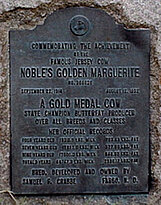
Noble’s Golden Marguerite was a Jersey Cow that was owned by Samuel F. Crabbe, a dairy farmer in the Fargo area who had imported seven purebred Jersey Cattle from the Island of Jersey (The Island of Jersey is the largest and most southerly island of the British Channel Islands.). He developed an outstanding Jersey herd and served as the President of the American Jersey Cattle Club. The culmination of his career as a Jersey breeder was the development of Noble’s Golden Marguerite. In 1921 she produced 977.69 pounds of butterfat, which at the time was the greatest production record ever achieved in North Dakota, by any breed of cow.
In 1913, the dairymen of the North Dakota, under Crabbe's leadership, secured an appropriation from the North Dakota Legislator sufficient to build the Dairy Building and the original dairy barns on the North Dakota Agricultural College campus.
When Noble’s Golden Marguerite died in 1932, the head of the Department of Dairy Husbandry, Professor J. R. Dice and the President, John H. Sheppard, friends of Sam Crabbe, proposed that she be buried in front of the Dairy Building on the North Dakota Agricultural College campus. She was buried in a grave in front of the Dairy Building on August 12, 1932. Shortly thereafter, a plaque, embedded on a boulder, commemorating her achievements was placed by her grave. The story should end here, but does not.
In 1976, Dairy Husbandry, which was a component of Animal Science, moved to Walster Hall. The Horticulture Science Department took over the Dairy Building, and had the concrete cow’s head that was mounted on the roof removed (now sitting on a pallet in archival storage), and had the plaque and concrete boulder commemorating Noble’s Golden Marguerite achievements move to the entrance of Shepperd’s Arena. In 1992 Horticulture Science moved and the building became the Engineering Technology Building. In 2009 plans for the Geosciences Department to move into the building were underway and as of 2010 it is the Geosciences Building. The plaque and concrete boulder still remain in front of Shepperd’s Arena and the cow’s head is still in storage, but there may be a movement underway to restore the plaque and boulder and the cow’s head to their rightful places in the near future.
Update May 2020: Demolition and excavation of the Geosciences Building in the spring of 2020 revealed the following: “when the building was being torn down, exploratory digging only revealed old bricks and clay.”
Petry Collection of Early Farm Technology
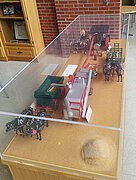
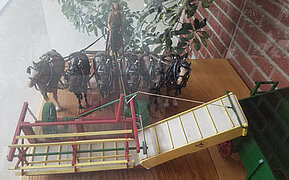
Redhawk Fountain
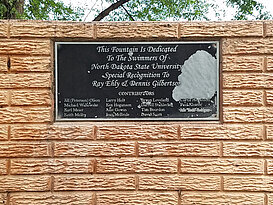
The fountain located to the east of Newman Outdoor Field and is dedicated to the swimmers of NDSU with special recognition to Ray Ehly and Dennis Gilbertson.
Rollo Statue

The Rollo statue north of the Sons of Norway lodge in central Fargo is a century old. It was one of five Norwegian monuments erected in Fargo in the decade following Norway’s independence from Sweden in 1905, part of a resurgence in ethnic pride led locally by Dr. Herman O. Fjelde of Wahpeton.
Rollo was a Norse conqueror originally known as Gange Hrolf. After plundering various northern European kingdoms for thirty years, Hrolf agreed to Frankish King Charles the Fat’s offer of a duchy northwest of Paris and the king’s daughter’s hand in marriage in return for defending Charles’s kingdom against further Norse attacks. Hrolf also agreed, at least nominally, to accept Christianity, and he was baptized under the name of Rollon (later anglicized to Rollo).
The Fargo statue is one of three replicas of an 1865 work by the world-renowned artist Arsene Letellier. In response to requests from the Sons of Norway, officials from the French city of Rouen agreed to task the Norwegian Society of America with finding a suitable location for the statue. Fargo was selected over its chief rivals Eau Claire, Minneapolis, and Moorhead, Minnesota, and so some 15,000 spectators gathered outside the Great Northern Railway depot in downtown Fargo to witness the unveiling of the statue on July 12, 1912. The event was marred by a minor diplomatic incident when a University of Wisconsin professor made offensive remarks about Catholicism, incensing the French dignitaries present and souring relations between Rouen and Fargo.
The diminished public visibility of Rollo’s current location reflects a decline in the Norwegian cultural presence in Fargo. According to the 1910 Census, 16.5% of Cass County residents at the time were either Norwegian immigrants or first-generation Norwegian Americans. Unlike the great celebration that greeted the statue’s arrival nearly a century before, the rededication ceremony in 1990, when the statue was relocated, attracted only a handful of onlookers. The passing of the immigrant generation can be considered the main determinant in the reinterpretation of Rollo and his movement to a less visible location.
This does not necessarily mean that Rollo’s new place in Fargo’s culture is any less significant, however. Standing in full view from the entrance to the Sons of Norway Kringen Lodge, Rollo is now in the company of those whose ancestors brought him to Fargo. Perhaps it is there, near a thriving stronghold of Norwegian identity, where Rollo can most effectively memorialize the city’s Scandinavian heritage.–Research by Jared Sullivan, HIST 489, NDSU, Spring 2007
Saddle and Sirloin Hall of Fame

Each year the Saddle and Sirloin members, in conjunction with the Little International, choose an outstanding individual in the field of agriculture. The Agriculturist of the year is honored at the hall of Fame Banquet and his/her portrait is hung in the Hall of Fame Gallery in Shepperd Arena.
Scythe and Cradle
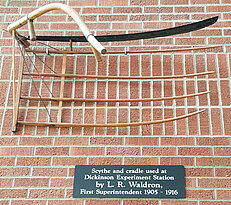
The scythe and cradle that hangs in the hallway of Loftsgard Hall, was used by L.R. Waldron at the Dickinson Experiment Station. He was the first Superintendent at the experiment station and was there from 1905 - 1916.
Scrappy-Williams Beagle Park
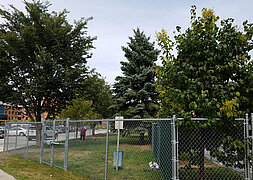

In late 2007, Kristi Williams, a Veterinary Technology student, approached the faculty and staff of the program with the idea of fencing a grassy area on the west side of Robinson Hall to make a dog park for the program's colony of beagles. Her reason for proposing the park was to help socialize the beagles to other dogs mainly because of Scrappy, one of the colony beagles. He had lost an eye at an early age to juvenile glaucoma and was, as his name suggests, scrappy with the other beagles. When she took an interest in him, as so many of the students do with the beagles, she started taking him to the city dog parks. There she realized that Scrappy was aggressive toward other dogs as well. It made sense to her that if we could socialize the beagles at a younger age, we would have better "dog citizens" to adopt out when it came time to do so. It was also hoped that the dog park would give them more exercise and enrichment as well as help them be quieter when people and other dogs pass by which would be appreciated by the new neighbors in the Living and Learning Buildings.
The park received it's name "Scrappy-Williams Beagle Park" in 2008 to recognize both Scrappy and Kristi. Without either of them, this dog park would have never happened. This park has provided a wonderful resource for the program and the beagles are beyond happy with it as well!
Theater Passion, Mask Sculpture
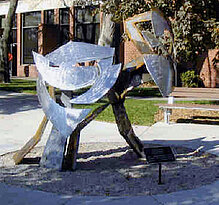
As part of the celebration of the 90th anniversary of the Little Country Theater, theater professor Don Larew commissioned a sculpture titled: Theatre Passion, for the south lawn of Askanase Hall, which was unveiled in October 2003. The following is the design statement from the artist, Todd W. Johnson (NDSU, Class of 1997): “The sculpture rises from the ground much like a production is built-from the ground up and with hard work and determination. The performance is the ultimate goal-which is represented by the comedy and tragedy masks. The masks are made of stainless steel and will be polished to a chrome-like finish, much like the performances of the Little Country Theatre. These masks are supported by a strong and sturdy framework of steel. The support structure will be much rougher in texture than the masks. It will be weathered and hammered to express the great effort that goes into the art of producing theatre.”
Theodore Roosevelt Statue
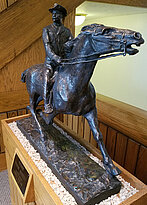
On October 9, 1972, a statue of Theodore Roosevelt by Norwegian artist Gustav Vigeland was dedicated to the university and placed in Old Main. It is located in the south entry outside the President's office.
We Will Never Forget Memorial
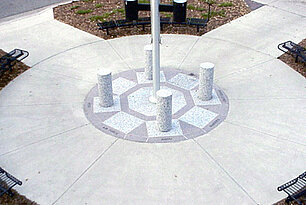
Located near the entrance to the NDSU Alumni Center, the memorial was dedicated on August 14, 2002, as part of a special two-day World War II reunion of NDAC veterans.
"The memorial has engraved stones for each of the branches of the military - Army, Air Force, Marines and Coast Guard. A larger stone is engraved with the message, 'This place is dedicated to those who have served and are currently serving in the Armed Forces. Through their spirit, sacrifice and commitment, they have preserved our rights of life and liberty. These granite stones serve as a symbol of our appreciation for their efforts to maintain our freedom and also as a reminder of the moral strength and awesome power that can flow whenever a free people are united together for a common cause.'" (It's Happening at State, August 21, 2002, p. 1)
Worst Memorial Grove
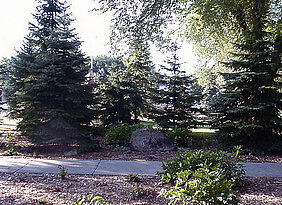
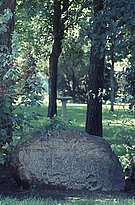
The Memorial Grove was the idea of President John Worst (1895-1916), who had a tree planted for each NDAC student who volunteered to fight in the Spanish-American War (1898). Although the exact date of the planting of the trees is not known, the stone marking the memorial grove was placed in July of 1937. Originally, the stone marker, and we believe the grove, was located south of Ceres Hall (across Administration Blvd.) and east of Old Main. The tornado of June 1957 destroyed two hundred elm trees on campus, including those in the Memorial Grove.
At some point the stone was moved, across the street from Ceres (Administration Blvd.), off the sidewalk and in the bush area, west of the garage of the President's House. Speculation is that the stone was moved during the building of the President's House in 1949.
The stone remained in that spot until the Summer of 2002, when it was again moved. It is now located in the arboretum by the campus main gate, off a pathway leading to the sidewalk by University Drive.
In 1895, John H. Worst was appointed president of NDAC. Although Worst was not the first president of NDAC, he is regarded as the "Father of NDAC." A considerable amount of progress was made during Worst's administration. The number of students steadily increased, and the staff increased threefold. Worst was successful in obtaining money from Andrew Carnegie in 1905 for the building of a campus library. Ten new buildings were constructed on campus, as well as gardens and trees. Political reasons are cited for Worst's retirement from NDAC in March of 1916. He was made president emeritus on April 5, 1919 by the Board of Regents.



